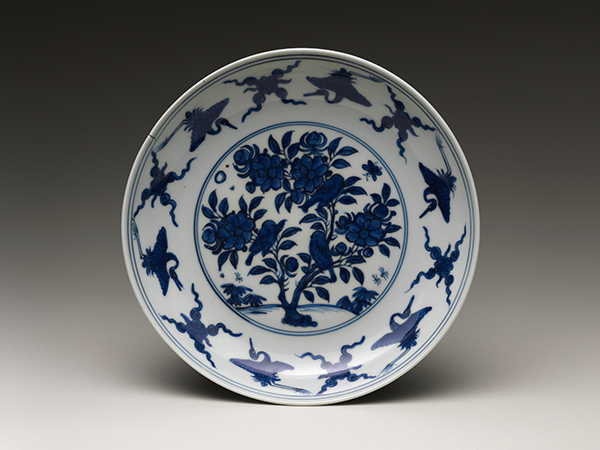End of the Ming Dynasty in China
This day in history, April 25, 1644, marked the end of the Ming dynasty (1368–1644) in China with the death of Chongzhen Emperor (1611–1644). Although the Ming period was turbulent politically and militarily, it also experienced a fabulous flourishing in the arts, particularly silk production, painting, printed books illustrated with woodblock illustrations, and, of course, porcelain.
 |
| China, Ming dynasty, Jiajing period, Dish with Flowers and Birds, dated 1565. Porcelain painted with cobalt blue under transparent glaze (Jingdezhen ware), 1 ¾" x 8 ½" (4.4 x 21.6 cm). Metropolitan Museum of Art, New York, gift of Stanley Herzman, in memory of Adele Herzman, 1991, 1991.253.48. |
Jingdezhen blue-and-white porcelain was among the most popular export items in Ming China. The earliest blue-and-white wares were made as early as the Tang dynasty (618–907 CE). Those, however, were cobalt pigments on earthenware, not porcelain. Cobalt blue-and-white porcelains were perfected during the Ming period and reached their peak of refinement during the following Qing dynasty (1644–1912). The technique mastered by Ming ceramic artists was the application of cobalt oxide designs on a white porcelain body, which emerges after firing, covered by a transparent glaze.
The Jingdezhen kilns were established in Jingdezhen City in 1368 by the first Ming ruler, the Hongwu Emperor (died 1398), to make blue-and-white wares for the imperial court. The blue-and-white wares (called qīng huā cí) were the most well-known among the Jingdezhen porcelains. Ming blue-and-white wares tended not to contain narrative decoration, but rather natural forms such as flowers, trees, and birds. Ming artists were renowned for unusual patterns, such as the rim pattern on this dish of the auspicious heron crane with flaming pearls of cosmic wisdom, both symbols for eternity.
The Ming dynasty pioneered many firsts, including opening China to Western trade, and the proliferation of printed books. But the period was especially known for constant political and military turmoil. The dynasty was founded by Zhu Yuanzhang, who had grown up in poverty in the Yellow River Valley as a result of years of famine and natural disasters that started in 1333. Rebellions against the “foreign” Mongols of the Yuan dynasty (1280–1368) naturally arose. Zhu quickly rose to leadership in a rebel army, which successfully conquered Nanjing (the Yuan capital) in 1356, chasing the Mongols north past the Great Wall. Zhu ultimately conquered Beijing in 1368, where he declared himself emperor.
Although the Hongwu Emperor (the name Zhu took) was a cruel and paranoid ruler (leading to an estimated 100,000 executions of civil servants, military leaders, and rebel warlords), Zhu oversaw the revitalization of Chinese culture that was considered neglected by the Yuan rulers. He expanded contact with India, the Persian Gulf, and the east coast of Africa. By 1557, China was exporting silk and porcelain, and entertaining European visitors.
The ultimate collapse of the Ming came about from a number of calamities in the 1630s: a severe financial downturn, an agricultural disaster due to drought and the disruption of seasonal temperatures by periods of prolonged cooling caused by the Little Ice Age (1303–1860), and constant insurgencies, which included Mongols. The final straw was the 1642 destruction of dikes on the Yellow River by rebels, which resulted in flooding that is thought to have killed tens of thousands of people. The last Ming emperor committed suicide in 1644 during a severe uprising by farmers.


Comments